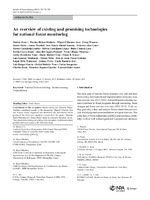An overview of existing and promising technologies for national forest monitoring

Date
2015-09Author
Matieu, Henry
Réjou-Méchain, Maxime
Cifuentes-Jara, Miguel
Wayson, Craig
Piotto, Daniel
Westfall, James
Michel-Fuentes, José María
Alice-Guier, Federico
Castañeda-Lombis, Héctor
Castellanos-López, Edwin
Cuenca-Lara, Ruby
Cueva-Rojas, Kelvin
Águila-Pasquel, Jhon
Duque-Montoya, Álvaro
Fernández-Vega, Javier
Metadata
Show full item recordAbstract
The main goal of national forest programs is to lead and steer forest policy development and implementation processes in an inter-sectoral way (FAO 2006). National forest monitoring systems contribute to forest programs through monitoring forest changes and forest services over time (FAO 2013). To do so, they generally collect and analyze forest-related data and provide knowledge and recommendations at regular intervals. The collection of forest-related data and their analyses have continually evolved with technological and computational advances (Kleinn 2002). For instance, ground measurements, such as diameter or height measurements, which were typically measured with measuring tape or forest compasses and relascopes, are now enhanced with new technologies, such as laser range finders. Furthermore, remote sensing is being increasingly used to improve ground sampling strategies (Maniatis and Mollicone 2010), to calculate forested land area and area changes (INPE 2006; INPE 2008; Hansen et al. 2013), and to detect many variables of interest such as forest fires, pest outbreaks, or trees outside forests (Barducci et al. 2002). The use of remotely sensed data together with ground-based observations has gained a lot of attention for estimating greenhouse gas emissions and removals associated with forests, particularly in the context of REDD+ (GOFC-GOLD 2010; GFOI 2014). During the last decades, the amount of information collected during forest inventories has thus grown rapidly and has, in turn, improved our ability to survey and manage many services such as biodiversity, carbon sequestration, or recreation. However, national forest monitoring approaches remain very heterogeneous from one country to another, and many national systems have still not taken the full advantage of newly operational technologies, despite an increasing availability of free, or at least less costly, data. This is probably because the use of these technologies to assess forest structural properties is, for the most part, used by only a few specialists and is largely confined to the research sector. The objective of this paper is to raise awareness by presenting, in a comprehensible way, some existing and promising technologies for supporting national forest monitoring.
Source
Annals of Forest Science (2015) 72:779–788. 10.1007/s13595-015-0463-zShare
Metrics
Collections
- Artículos [40]
The following license files are associated with this item:


